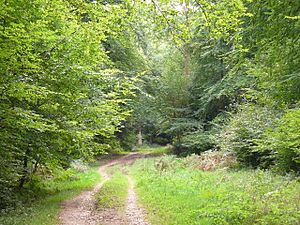Ranmore Common SSSI facts for kids
| Site of Special Scientific Interest | |
 |
|
| Area of Search | Surrey |
|---|---|
| Interest | Biological |
| Area | 224.3 hectares (554 acres) |
| Notification | 1986 |
| Location map | Magic Map |
Imagine a special place in nature, protected so that amazing plants and animals can thrive! Ranmore Common SSSI is one of these important areas. It's a large natural space, about 224 hectares (that's like 554 football fields!), located in Ranmore Common, near Dorking in Surrey, England. This site is officially known as a Site of Special Scientific Interest (SSSI) because it's home to unique wildlife and habitats. It was given this special protection in 1986 to make sure its natural beauty and biodiversity are kept safe for the future.
Contents
Exploring Ranmore Common SSSI
Ranmore Common SSSI is a fascinating mix of different natural environments. Most of the area is covered by woodlands, some of which are very old, meaning the trees have been growing there for hundreds of years! But it's not just trees; you can also find open areas of heathland and rough pastures. This variety of habitats makes the common a perfect home for many different kinds of plants and animals.
The Wonderful Woodlands
The woodlands at Ranmore Common are a key part of what makes this place special. The main trees you'll see are different types of oaks, like the pedunculate oak and the sessile oak. These mighty trees provide shelter and food for countless creatures.
Underneath the tall oaks, there's a layer of smaller trees and shrubs. You might spot holly with its shiny green leaves and red berries, silver birch trees known for their peeling bark, and ancient yew trees. Yew trees can live for an incredibly long time, sometimes over a thousand years! These different layers of plants create a complex ecosystem where many species can live.
Heathland and Pastures
Beyond the dense woods, Ranmore Common also features areas of heathland. Heathland is a type of open land with low-growing shrubs like heather. These areas are often quite dry and sandy. They provide a different kind of habitat compared to the woodlands, attracting specific types of insects and birds.
There are also areas of "rough pasture." This means open grassy fields that aren't regularly mowed or farmed. These wilder grasslands are important for insects and small mammals, offering places to feed and hide. The mix of woodlands, heath, and pasture makes Ranmore Common a very diverse natural space.
Amazing Animals of the Common
Ranmore Common SSSI is a busy place for wildlife, especially birds and insects. It's a great spot for birdwatching, as many different species come here to breed and raise their young. The varied habitats provide plenty of food and safe nesting sites.
Insects: Moths and Butterflies
The site is particularly important for its invertebrates, which are animals without backbones, like insects. Two special insects that live here are the satin wave moth and the white admiral butterfly.
- Satin Wave Moth: This small moth has a delicate, wavy pattern on its wings, which are usually a pale, creamy color. They are often found in grassy areas and woodlands.
- White Admiral Butterfly: This is a beautiful butterfly with dark wings marked by striking white bands. They are often seen gracefully gliding through woodland clearings. Their caterpillars feed on honeysuckle, which grows in the common.
Protecting places like Ranmore Common SSSI helps ensure that these fascinating insects and many other creatures have a safe home where they can continue to thrive.

